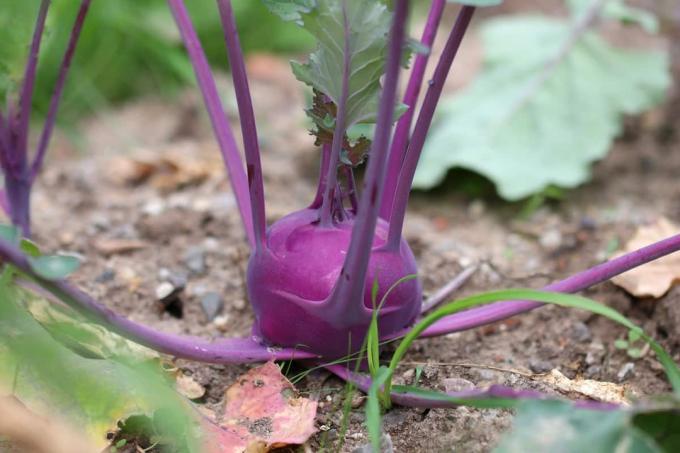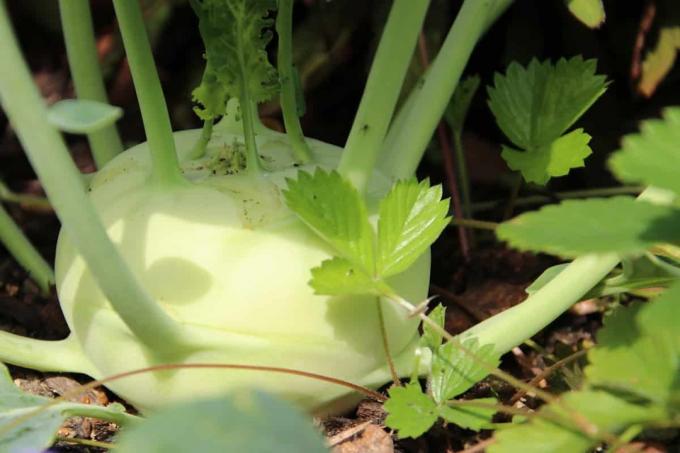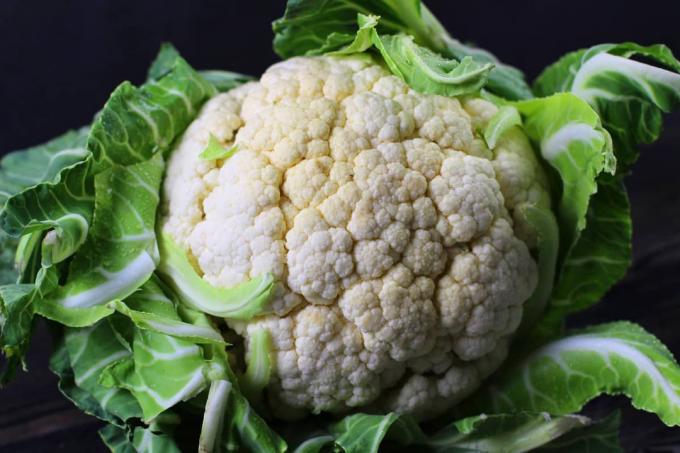

Table of contents
- Good neighbors for the kohlrabi
- Small footprint and fast growth
- Changing plant neighbors in the course of the year
- neutral neighbors
- Kohlrabi as a filler
The search for a good neighbor for the kohlrabi (Brassica oleracea var. gongylodes L.) is not difficult because there is no shortage of suitable candidates. Other factors may decide which vegetable it will ultimately be.
Good neighbors for the kohlrabi
Kohlrabi, botanically Brassica oleracea var. gongylodes, is a so-called medium feeder that needs some nutrients, but not an excess of them. This trait makes it possible for him to stand alongside his own kind as well as some weak and heavy consumers.
With these plants he feels particularly comfortable in the garden bed:
- beans
- Peas
- cucumbers
- potatoes
- leek
- radish
- Beetroot
- salad
- celery
- spinach
- tomatoes
A notice:
If you often had to struggle with the caterpillars of the cabbage white butterfly when growing kohlrabi, then you should definitely try a suitable mixed culture. It is a tried and tested remedy against the spread of this pest.
Small footprint and fast growth
When deciding which plant neighbor is ideal for the kohlrabi, the typical growth of the individual plant varieties should also be taken into account. Kohlrabi is a fast-growing tuber that can start growing early in the year. Young plants are usually grown indoors and planted out from the end of March. Depending on the variety, the first tubers are ready to harvest after eight to twelve weeks, i.e. around June.

If a tuber is actually harvested, the entire plant disappears from the bed. This frees up space completely for your neighbors. This is why kohlrabi, for example, is an ideal accompaniment to tomatoes and potatoes at an early stage of their growth because it is harvested before the two nightshade plants spread out develop.
Tip:
There are different types of kohlrabi on the market. If you only have a little space in the garden that you want to make the best use of, then choose one of the leafless varieties.
Changing plant neighbors in the course of the year
So that the harvest time lasts longer or evenly distributed over the gardening season, kohlrabi is reseeded at regular intervals. Because only young kohlrabi taste tender, while older specimens become increasingly woody. This cultivation process makes a flexible mixed culture possible by selecting the planting neighbor that suits best at the respective planting time. So early in the year kohlrabi can stand next to lettuce, while late in the year it can be in a bed with leeks, as these initially take up little space or are too small. only strives upwards.
Tip:
Most gardeners go for the thick tuber of this vegetable, while the leafy greens end up in the compost or as rabbit food. Few people know that the young leaves are edible and aromatic, and how spinach can be prepared.
neutral neighbors
A good planting neighbor for the kohlrabi can usually be found in a colorfully planted garden. And if that isn't possible, then there are plants that don't promote growth, but don't harm or damage it either. take no harm yourself.

These are the neutral companions:
- strawberries
- fennel
- Garlic
- carrots
- radish
- zucchini
Kohlrabi as a filler
Kohlrabi is a wonderful plant that can be used to fill small gaps in the bed. Whenever a place becomes free and is not otherwise used, you may sow a few seeds or plant a young kohlrabi. In which neighborhood the kohlrabi will grow is secondary. The only thing you should definitely avoid is the close proximity to other types of cabbage and onions.
Tip:
Despite good neighborliness, every plant needs enough space to develop. Therefore, keep a planting distance of about 15 cm. Giant kohlrabi should have 20 to 25 cm of free space all around.
 Home editorial office
Home editorial office
Learn more about vegetables

Mixed culture: 9 good neighbors of Swiss chard
The cultivation of Swiss chard in the home garden is uncomplicated and the harvest rewards are considerable. Varieties with colorful stems are also real eye-catchers in the bed. Carefully selected neighboring plants contribute to healthy growth.

Mixed culture: 17 good neighbors of beetroot
Because of its uncomplicated nature, beetroot is often cultivated. To optimize the health and taste of root vegetables, it is advisable to plant good neighbors. These have a positive effect on growth and protect against pests and fungi.

12 good neighbors of cucumbers | mixed culture
Cucumbers are popular vegetables for mixed crops with other crops. Root vegetables are just as suitable as lettuce as plant neighbors. Plantings with kitchen herbs are attractive because they enrich the garden and kitchen. Flowering ornamental plants also improve growth.

10 good neighbors for onions | mixed culture
Good neighbors for onions or a beneficial mixed culture is not only natural, but It also reduces the maintenance effort, can keep pests away and the risk of disease to reduce. You can find out which plants are suitable here.

Mixed culture: 14 good neighbors of cauliflower
Cauliflower, also known as cheese or cauliflower, is a cultivated form of cabbage. It can be prepared in a variety of ways and can be eaten raw or cooked. Cultivation is not unproblematic, because cauliflower is very demanding.

Cucumbers: Cultivation of cucumbers in greenhouses/outdoors
Cucumbers are one of the most popular vegetables in this country. So what could be more obvious than growing your own refreshing cucumbers. Because cucumbers are heat-loving plants, they thrive in a greenhouse. If you don't have a greenhouse, you can also cultivate different varieties outdoors. You can find out what you should consider when growing cucumbers here.
